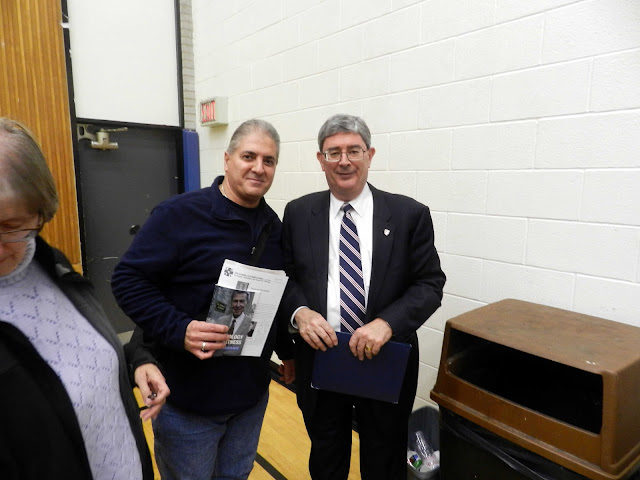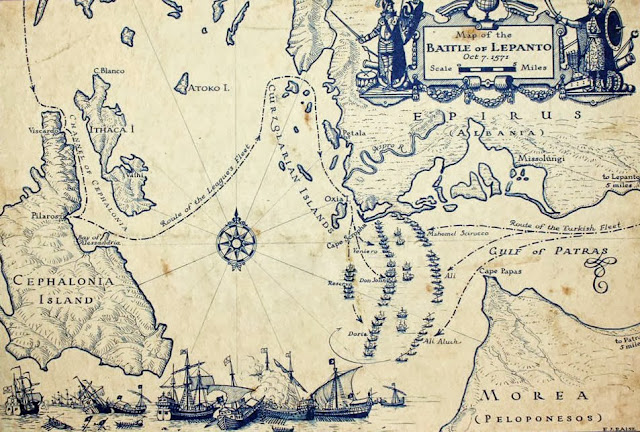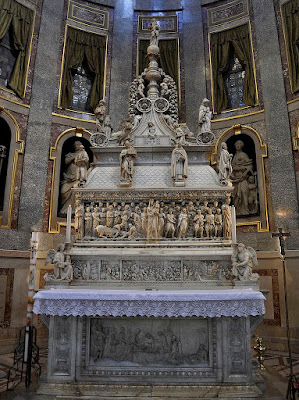 |
George Weigel and myself at his speaking engagement in Toronto |
It was an extraordinarily gratifying feeling to be in attendance with Mr. Weigel, who I greatly admire and whose work and accomplishments I hold in high regard. I had the added privilege of introducing myself and spoke with him for several minutes, that included the expressing of my respect and gratitude for all his work.
For those of you who are not familiar with George Weigel, he is a Distinguished Senior Fellow at the Ethics and Public Policy Center (EPPC), a Catholic theologian and a leading American public intellectual. He also holds EPPC’s William E. Simon Chair in Catholic Studies, the author of twenty books and his weekly column, The Catholic Difference, is syndicated to sixty newspapers. Weigel's essays and reviews regularly appear in major opinion journals and newspapers across the United States. He is the Senior Vatican Analyst for NBC News and a frequent guest on television and radio.
I first discovered George Weigel in 2001, when the DVD version of Witness To Hope, was aired on WNED Buffalo-Toronto, the local Public Broadcasting System (PBS) station. After watching it, I vividly recall becoming fascinated with the life of St. John Paul II—a fascination that only increased over time as I became more knowledgeable about his life—that I purchased the DVD.
After watching the documentary again, it wasn't long before I purchased the book version of Witness To Hope from the Rosary Center, which as of this post, still lists it in their book catalog page.
In addition to Witness To Hope, I have purchased and read three other books authored by Weigel: The End and the Beginning, a book on the legacy and the last years of St. John Paul II's life; God's Choice: Pope Benedict XVI and the Future of the Catholic Church; and Evangelical Catholicism, a book on the deep reform of the twenty-first century Church.
George Weigel's enormous contributions to the Church and the world are a treasure trove of information for anyone who seeks understanding, knowledge and the truth.
Catholic Civil Rights League Annual General Meeting
The Annual General Meeting (AGM) first began with Mass at 5:30pm at Holy Rosary Roman Catholic Church located at 354 St. Clair Ave. West. Having to travel from suburbia, I allowed extra time for traffic, road construction, accidents, and any other delays. I arrived at around 4:30pm, which afforded me an opportunity to walk around for a few minutes and admire the fifteenth century English Gothic architecture of this church.
 |
| Holy Rosary Catholic Church, St. Clair Ave., Toronto |
Directly after Mass, everyone went to the parish hall for some food and refreshments. It was during this time that I had the opportunity to meet the executive director, Christian Domenic Elia, PhD., and mingle a little, meeting new people in the process, and reconnect with a few familiar faces.
Phil Horgan, president of the CCRL, presided over the meeting. As a non-member, I listened attentively to the meeting's agenda, that included a summary of the work the CCRL is involved in. It was quite impressive to hear Horgan speak of issues that I have personally become interested in and one in particular that I have blogged about: the moral disorder cultivated in the medical profession with the ushering in of euthanasia and assisted suicide, and the removal of conscience rights, spearheaded by the College of Physicians and Surgeons (CPSO). I was first alerted to this issue when the CPSO held a public consultation for the drafting of the Professional Obligations and Human Rights policy, which I blogged about at length at my post, Professional Obligations and Human Rights - An Anti-Life Policy From Ontario's College Of Physicians And Surgeons.
After completing all the official business of the meeting, Horgan moved on to the much anticipated segment, George Weigel's talk. He gave a brief summary of Weigel's accomplishments and credentials, a summary so impressive that it seemed to fuel the audience's enthusiasm, which was finally released with the thunderous applause as Weigel approached the microphone.
George Weigel's Talk
Seated dead center in front of George Weigel, approximately thirty feet away, I watched and listened to what can only be described as one of the most thought provoking and intriguing talks I have ever had the privilege of attending.
Steeped in important details and references, Weigel's talk proved to be not only a time of learning, understanding and discovery of some of the key essential issues we as Catholic face in society, and the world as a whole, but a time of inspiration that has personally encouraged me to seek out the readings on the many topics he covered: the "dictatorship of relativism" taken from the homily of then, Cardinal Joseph Ratzinger (Dean of the College of Cardinals) on April 18, 2005; expressive individualism; the "leviathan state" and its accommodation to and implementation of "expressive individualism" through political correctness; the ever shrinking Catholic sphere; the growing need for living our Catholic faith with fortitude and certitude, rendering unto Caesar the things that are Caesar's, and unto God the things that are God's; and the urgent need for the Church to embark on a serious effort to implement what St. Pope John Paul II called for some thirty years ago, the New Evangelization.
 |
| George Weigel's talk to the CCRL |
He also referred to the Little Sisters of the Poor, a Catholic Order of nuns who minister to the poor elderly, who were forced to defend themselves against the Obama administration's attempted imposition of the Affordable Care Act's, birth control mandate.
The Affordable Care Act requires all American insurance plans to cover twenty varieties of the Food and Drug Administration (FDA) approved contraceptives at no cost to patients; in other words the "Little Sisters" would have had to provide coverage for contraception in their insurance plans.
Weigel's talk also included a call to Catholics to fight the good fight, by speaking out about the many issues we face in society, identifying the moral disorder in the process. He also pointed out that part of the good fight entails forming groups and associations.
Weigel reminded all of us that we are in mission territory, that there is a great need for the New Evangelization, to reclaim what was once Christian territory, which begins at our own kitchen tables.
For a talk that lasted approximately ninety minutes, it was a real privilege to have benefited from George Weigel's generosity to be amongst us, here in Toronto. Attending the AGM was time well spent; a faith strengthening time that has really encouraged me to improve upon my "labouring in the vineyard."
Saint John Paul II's Apostolic Exhortation Christifideles Laici
If you are somewhat uncertain as to what I mean by "labouring in the vineyard," it is in reference to Saint John Paul II's Apostolic Exhortation Christifideles Laici (Christ's Faithful People), in which he explained the vocation and mission of the laity in the Church and in the world. He identified in the first section of the Introduction, who the lay members of Christ's Faithful People are:
...[T]hose who form that part of the People of God which might be likened to the labourers in the vineyard mentioned in Matthew's Gospel: "For the Kingdom of heaven is like a householder who went out early in the morning to hire labourers for his vineyard. After agreeing with the labourers for a denarius a day, he sent them into his vineyard." (Matthew 20:1-2)Our "vineyard" is the vast world we live in, one that is to be transformed according to God's plan whereby everyone, both of men and women, are called to labour in anticipation of the final coming of the Kingdom of God.
Perhaps Saint John Paul II's "It is not permissible for anyone to remain idle" quote from Christifideles Laici is one of the most relevant quotes of the entire document; one that has certainly increased in its relevancy in today's world. Here is the quote contained in the paragraph it was written in, "A new state of affairs today both in the Church and in social, economic, political and cultural life, calls with a particular urgency for the action of the lay faithful. If lack of commitment is always unacceptable, the present time renders it even more so. It is not permissible for anyone to remain idle." (3)
Christifideles Laici's importance and relevance is something that George Weigel also referred to in Evangelical Catholicism, Chapter Nine: The Evangelical Catholic Reform of the Lay Vocation:
Although the Second Vatican Council's Decree on the Apostolate of the Laity remains an important reference point for Evangelical Catholicism in the twenty-first century, the Magna Carta of the deep reform of the lay mission will be found in the 1988 postsynodol apostolic exhortation Christifideles Laici, a bold exploration of the various evangelical roles of "Christ's Faithful Laity," written by a pope, John Paul II, who until his young-adult years intended to live out his Christian life as a layman, and who as a priest and bishop had a broader pastoral experience of the lay apostolate than any other pope since the early Christian centuries. (192)I could not help think of both Christifideles Laici and Evangelical Catholicism, and the connection to Weigel's point of the importance and urgency of implementing the New Evangelization. I consider both references key essential readings for anyone who is serious about boldly evangelizing and affecting a real positive change in society.
Catholic Civil Rights League
My attendance at the AGM was my first contact with this organization. I originally discovered the CCRL when reading about their opposition to the parliamentary report, Medical Assistance in Dying: A Patient-Centred Approach; a report that ushered in euthanasia and assisted suicide as new includes in palliative care, and the removal of conscience rights for medical professionals who object to the "new includes," based on religious or moral beliefs. I blogged about this at my post, My Support For Medical Professionals and Their Conscience Rights.
I was impressed with the CCRL's opposition. It certainly was encouraging to know that there was an active Catholic organization who cared to voice their concerns and speak out about the increasing moral disorder in Canada.
At the AGM, I was further impressed by the humility with which Phil Horgan expressed the need to focus on raising funds; that such a reality had to become a greater priority in order for the CCRL to effectively take action in the future and reach its goals.
If you visit the web site, you will be no doubt be impressed by their work. But what you may not know, that might further impress you, is that much of it is done through the generosity of time and effort of its members, at no charge, who sincerely care and are driven to affect a positive change in society.
Here is how the CCRL describes itself from their About page:
The Catholic Civil Rights League (CCRL) is a national lay Catholic organization committed to combating anti-Catholic defamation, working with the media to secure a fair hearing for Catholic positions on issues of public debate, and lobbying government and intervening in court challenges in support of law and policy compatible with a Catholic understanding of human nature and the common good.
Founded in 1985 as an independent lay organization, the CCRL received permission from the late Gerald Emmett Cardinal Carter to use the name Catholic. With a Board of Directors and membership that spans the country, the CCRL is faithful to the teachings of the Magisterium and works in cooperation with local bishops across Canada.
The work of the CCRL is exclusively sustained through donations.
If the work of the CCRL resonates well with you, and you are seeking to donate to a worth while organization, you may want to consider the CCRL.
Conversions and the Spiritual Battle
One of the most important points that Weigel made regarding the desired changes in society, was that if positive changes were to occur, they would be realized as a result of conversions.
Conversions are definitely something that we all need to pray for. One can only imagine how different the landscape would be with the increased personnel and other resources, affording us the opportunity to better establish and defend moral order, justice, peace, and the building up of the common good.
We need only look to the times of St. Dominic and the Albigensian heresy, and how it was eradicated from Southern France through the conversions brought forth by the powerful intercession of the Blessed Virgin Mary and that most effective weapon against the evils of society, the Rosary.
I think it is fair to say that we, as human beings, can at times forget that the battle is primarily a spiritual battle, that must be primarily fought with spiritual weapons. Like any spiritual battle it should begin with and be sustained by time and prayer (on our knees) in front of the Blessed Sacrament. Add to this frequent Mass attendance, daily recitation of the entire Rosary, and fasting.
The enemies we fight are unseen enemies as St. Paul warns us in Ephesians: The Whole Armour of God, "For our struggle is not against enemies of flesh and blood, but against the rulers, against the authorities, against the cosmic powers of this present darkness, against the spiritual forces of evil in the heavenly places." (Eph 6:12)
Conversions and the Spiritual Battle
One of the most important points that Weigel made regarding the desired changes in society, was that if positive changes were to occur, they would be realized as a result of conversions.
Conversions are definitely something that we all need to pray for. One can only imagine how different the landscape would be with the increased personnel and other resources, affording us the opportunity to better establish and defend moral order, justice, peace, and the building up of the common good.
We need only look to the times of St. Dominic and the Albigensian heresy, and how it was eradicated from Southern France through the conversions brought forth by the powerful intercession of the Blessed Virgin Mary and that most effective weapon against the evils of society, the Rosary.
I think it is fair to say that we, as human beings, can at times forget that the battle is primarily a spiritual battle, that must be primarily fought with spiritual weapons. Like any spiritual battle it should begin with and be sustained by time and prayer (on our knees) in front of the Blessed Sacrament. Add to this frequent Mass attendance, daily recitation of the entire Rosary, and fasting.
The enemies we fight are unseen enemies as St. Paul warns us in Ephesians: The Whole Armour of God, "For our struggle is not against enemies of flesh and blood, but against the rulers, against the authorities, against the cosmic powers of this present darkness, against the spiritual forces of evil in the heavenly places." (Eph 6:12)
May we never lose heart to fight the good fight and pray for God's mercy and the Blessed Virgin Mary's intercession.




